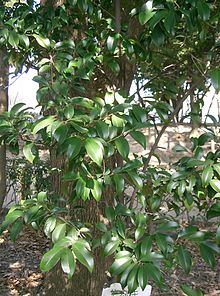Bulky shrub
| Bulky shrub | ||||||||||||
|---|---|---|---|---|---|---|---|---|---|---|---|---|

Bulky shrub ( Cleyera japonica ) |
||||||||||||
| Systematics | ||||||||||||
|
||||||||||||
| Scientific name | ||||||||||||
| Cleyera japonica | ||||||||||||
| Thunb. |
The bulky shrub ( Cleyera japonica ) is a species of plant in the Pentaphylacaceae family . It is originally found in southeast China , Taiwan , southern Japan , northern India , Nepal and Myanmar .
description

Vegetative characteristics
The bulky shrub grows as an evergreen shrub or tree and reaches heights of 2 to 10 meters. The shrub gives off an intense, characteristic odor. The young twigs are stem-round and initially have a grayish-brown bark . The branches are slightly ribbed and bare. The bare terminal buds are conical with a length of 1 to 1.5 cm.
The alternate leaves arranged on the branches are divided into a petiole and a leaf blade. The bald petioles have a length of 7 to 10 (to 12) mm. The simple, leathery, bald leaf blade is elliptical, narrow-elliptical, oblong, oblong with a length of (3.5 to) usually 5 to 15 cm and a width of (1.2 to) usually 2.5 to 6 cm elliptical, oblong-lanceolate, obovate or obovate-elliptical with a smooth edge. On each side of the main artery there are six to eight, rarely up to twelve, lateral nerves.
Generative characteristics
From May to June, the bulky shrub bears its flowers individually or in groups of three or rarely in groups of five in a leaf axil, each above an early falling bract and a 1 to 3 mm long, bare flower stalk.
The relatively small, hermaphrodite flowers are radial symmetry and five-fold with a double flower envelope . The five free, with about 2.5 mm × 2.5 mm egg-shaped to circular sepals have a ciliate edge and a rounded end. The five free, white petals are obovate-oblong with a length of about 8 mm. The 25 to 30 stamens have a length of 4 to 6 mm. The stamens are bare. The anthers, which are more or less egg-shaped with a length of about 1.5 mm, have thin hairs ( trichomes ). The spherical, bald ovary is two-chambered with more than ten ovules in each chamber. The approximately 6 mm long stylus ends with two lobes.
The small, spherical, berry-like fruits with a diameter of 8 to 10 mm ripen from October to December and then turn purple-black. The dark brown shiny seeds are flattened and have a diameter of about 2 mm.
The number of chromosomes is 2n = 90.
Cultural and usage
In Japanese the shrub is called Sakaki ( サ カ キ or 榊 ). As a sacred plant of Shinto , it is offered in Japan in Shinto shrines and on house altars ( Kamidana ). In the Kamidana a branch is set up on the right and left, which is renewed twice a month, on the first and on the fifteenth.
The shrub is a popular garden plant in Japan's rural areas. It grows in warm regions south of the Kantō area. In the Kantō area and north of it, the related Hisakaki ( Eurya japonica ) is planted instead of the Sakaki and used for the Shintō ceremonies. Sakaki and Hisakaki can be distinguished by the shape of the leaves: If the leaf is unrippled, smooth and completely green, it is the Sakaki, if the leaf is small and jagged, it is the Hisakaki. In order to better distinguish the Sakaki, it is also referred to as the "original Sakaki" ( 本 榊 honsakaki ).
In Central Europe, the bulky shrub is used as a container plant .
etymology
The original meaning of "Sakaki" is "evergreen shrub" and it was spelled 繁 木 . Another interpretation is that the tree is on the border ( 境 saka ) between the world of humans and the kami , which is why the name was written 境 木 . The character 榊 in use today is a combination of tree ( 木 ki ) and kami ( 神 ).
The generic name Cleyera honors the German pharmacist Andreas Cleyer (1634 - 1697/98), who entered the service of the Dutch East India Company in 1661 and collected plants.
Systematics
The first publication of Cleyera japonica was made in 1783 by Carl Peter Thunberg in Nova Genera Plantarum , 3, pp 68-69. It no longer belongs to the Theaceae family , but to the Pentaphylacaceae .
There are two varieties:
- Cleyera japonica Thunb. var. japonica : It occurs in Japan, in southern Anhui , in Fujian , in Guangdong , in eastern and northern Guangxi , in southeastern Guizhou , in Henan , in western Hubei , in Hunan , in southern Jiangsu , in Jiangxi , in eastern and western Sichuan , Taiwan and Zhejiang at altitudes between 200 and 1200 meters.
- Cleyera japonica var. Wallichiana (DC.) Sealy : It occurs in northern India, Myanmar , Nepal and China in western Sichuan , in southeastern Xizang and in western Yunnan at altitudes between 1600 and 2000 meters.
swell
- Tianlu Min & Bruce Bartholomew: Theaceae in der Flora of China , Volume 12, 2007, p. 443: Cleyera japonica - Online. (Section description and systematics)
Individual evidence
- ↑ a b Inoue Nobutaka : "Sakaki" . In: Encyclopedia of Shinto. Kokugaku-in , June 2, 2005 (English)
- ↑ Lotte Burkhardt: Directory of eponymous plant names . Botanic Garden and Botanical Museum Berlin, Free University Berlin Berlin 2016. ISBN 978-3-946292-10-4 , doi: 10.3372 / epolist2016
- ↑ First publication scanned at biodiversitylibrary.org.
- ↑ a b Tianlu Min & Bruce Bartholomew: Cleyera Thunberg - the same text online as the printed work , In: Wu Zheng-yi, Peter H. Raven, Deyuan Hong (eds.): Flora of China. Volume 12: Theaceae. Science Press and Missouri Botanical Garden Press, Beijing and St. Louis 2010.

